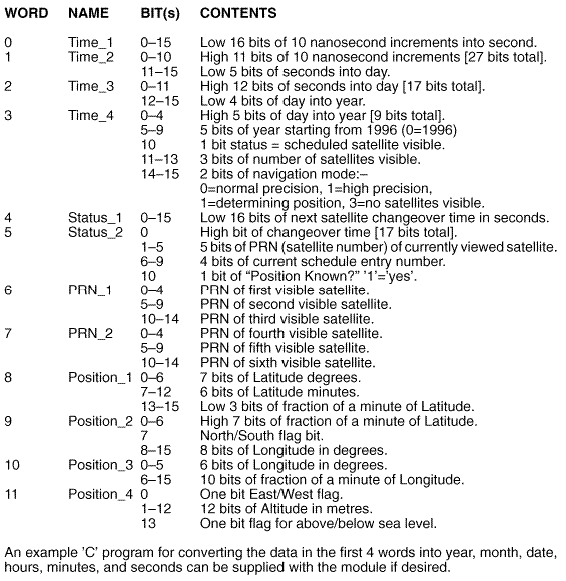
 |
Hytec Electronics Ltd. |

|
VME GPS2092 Event Time Stamp & Time–of–Day/Year Clock Product Description This is a double–width module performing event time stamping to very high accuracy by exploiting the US Department of Defense GPS or Global Positioning Satellite System. A front–panel BNC connector links to a small antenna/preamp which must be located out–doors with a clear view of the sky. Through this the internal receiver module tracks up to 6 satellites simultaneously, and can determine position within 100m and time to within 20 nanoseconds. An internal 68EC030 with 68882 coprocessor running at 40MHz interfaces to the internal GPS engine via RS232 and has 1K x 16 bits dual–ported RAM accessible via the VME port. Front–panel LEMOs are provided for NIM or TTL Event Trigger and Fast Clear inputs and there is a 1 Pulse–per–second (1PPS) TTL output LEMO connection. Using a 50MHz counter with two 32–bit latches, the processor receives counter values (interrupt driven) corresponding to the 1PPS pulse from the GPS engine followed by an RS232 data stream from the engine giving correction information. Front panel Event pulses cause the counter value to be stored in a separate latch and the processor is interrupted to read that value. From these pieces of information, the processor then calculates the exact event time and stores this in the Dual–ported RAM. The Data format is 4 x 16–bit words with 2 x 16–bit words of status information. The time format is UTC (Co–ordinated Universal Time) by default. The VME port provides facilities for interrupt signals from and to the internal processor. The speed of the calculation allows operation at high (>1kHz) trigger rates. When the Time Stamp calculation is complete a VME interrupt may be generated if wished. If a fast clear pulse arrives during the cycle then the process is aborted and the module immediately rearmed. There are two basic modes available depending on whether high relative precision is required between two or more GPS2092 modules. In Standard Accuracy Mode no user intervention is needed, the unit automatically determines its position and commences operation on power–up. Position data is continuously available through several VME registers, and use on a moving platform is possible. Absolute Time Stamp error in this mode is normally less than 100nsec with respect to UTC. This is due to the time information from each satellite having a small “dither” applied. If the US government bows to recent pressure to remove this “selective availability” from the time signal then the Absolute accuracy will be closer to 20nSec. Upon first power–up the module will require about 15 minutes to acquire more than four satellites. Due to battery backup the module will be able to reacquire satellites within a matter of seconds. In High Accuracy Mode the relative precision of GPS2092 units separated by up to several hundred km is expected to be 20nsec or better. In order to enter High Accuracy Mode all units are first instructed to survey their antenna positions which must not change. This process takes 24 hours. A “Common View” tracking schedule is then generated and entered into all units. This takes advantage of the fact that the random “dither” on each satellite is the same for all receivers obtaining time from it, so relative timing accuracy remains at 20nSec or better. A PC program is available to assist with schedule generation. The 68EC030 may be accessed from the VME bus via the Dual–ported RAM for configuration, scheduling etc. Among other options it is possible to request alternative Time Stamp formats, for example Astronomical Time in Modified Julian Days. The unit may be used as a trouble–free calendar/clock by injecting trigger pulses and collecting the time stamp as normal. This facility may be used for testing. A diagnostic RS232 terminal connection is provided on the front panel for set–up of the 68EC030 and for test purposes. Front–panel LEDs indicate module power, receiver tracking satellites, accuracy mode etc. VMEBus Access All VME access is by A16 short addressing. The start address of the module’s registers is set by a HEX rotary switch. The unit occupies 4K of VME space. At the start address, there is a standard Hytec Electronics Ltd. set of VME registers. These allow the user to write the interrupt vector, read manufacturer ID and module type and read and write the control and status register (CSR). The CSR includes module booking, reset and interrupt enable functions. At base address plus 2K, the user can access the dual ported RAM. All accesses are D16/D08,OE. On-board links allow the user to set the IRQ line to be used, selecting IRQ4, IRQ5, IRQ6, or IRQ7. |
Dual-Ported RAM Data Format

| Hytec Electronics Ltd Post : 5 Cradock Road, Reading, Berkshire, RG2 0JT, England. Phone : +44 (0)118 9757770 Fax : +44 (0)118 9757566 |